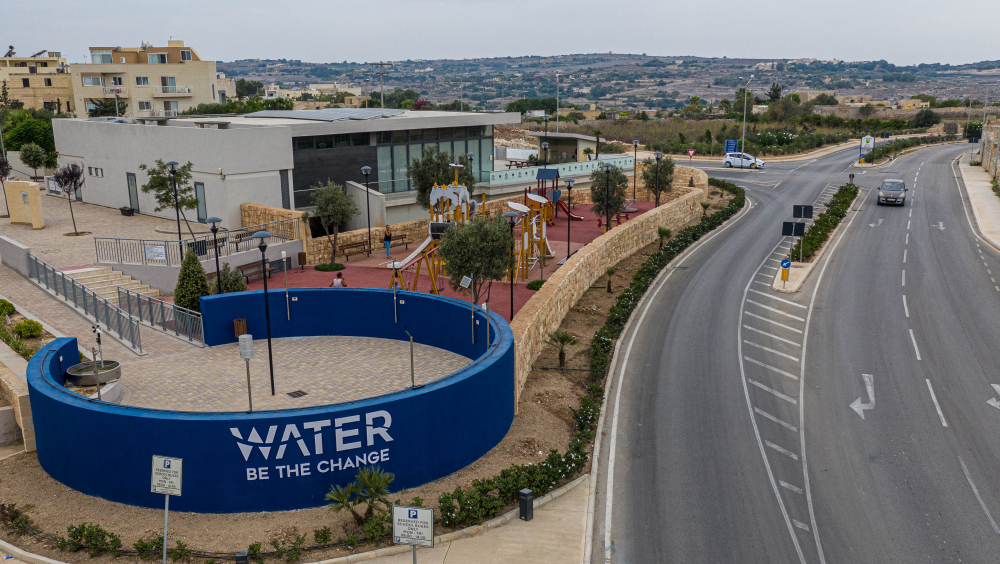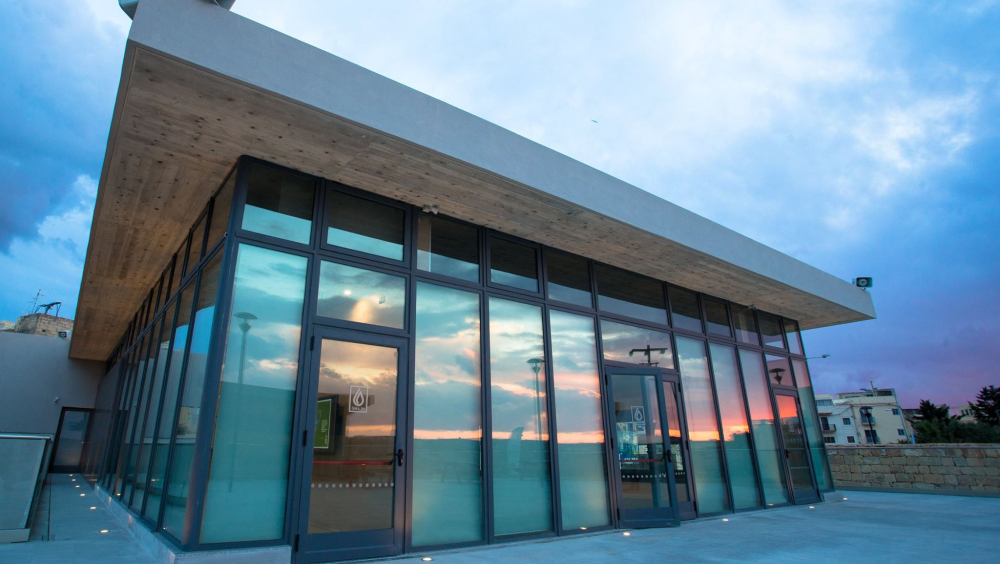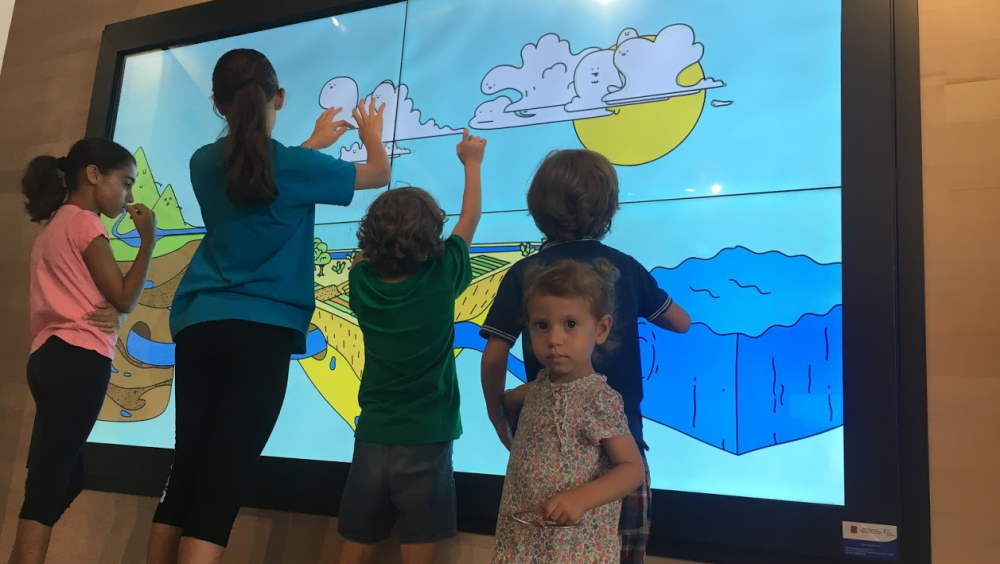Ghajn: National Water Conservation Awareness Centre
The National Water Conservation and Awareness Centre locally known as “Ghajn” has the primary aim to raise awareness on the challenges facing the water sector in the Maltese Islands within a broad context of sustainable water resources management. Since the official opening in April of 2017, the Centre has developed into a national information point for visitors where they can learn more about the need for water to be used sustainably, in view of the emerging environmental challenges to the water environment in Malta in relation to climate change impacts. Amongst the various educational platforms used at the Centre, such as traditional games and puppet shows the Centre also has interactive audio-visual presentations, augmented reality technology and other interactive games on large wall screens to send our message in a ‘fun and interactive’ manner. One of the favourite characters amongst our visitors is the Fairly Hydrated Knight, this character is featured in the interactive game with the same name. This interactive game also has a dedicated book, puppet characters as well as a puppet show dedicated to the historical aspect of water culture in Malta through the ages.
The Maltese Islands face significant challenges due to the scarcity of natural water resources due to the natural drought conditions (The Maltese Islands contend with semi-arid climatic conditions with an average annual rainfall of 550mm) and high population density (around 1,300 inhabitants per square kilometre which generate a high specific water demand).
The main target of the Centre is our future generation with a specific focus on primary and secondary school students, attending through organised school visits. In fact, all the interactive games (which have been specifically developed for the Centre) have themes that are concurrent with the present National Curriculum being taught in local schools. Educators that bring their students to the Centre can use this ‘fun’ (non-formal) setting to consolidate the lessons that are being taught at school in a formal way. The Ghajn Centre is also being developed into an educational hub for visitors other than just to raise awareness on water to also to increase awareness and knowledge on energy efficiency and sustainability in a holistic manner.
The Maltese islands are by far the most densely populated EU Member State, with a population density exceeding the 1200inh/km2. With an area of just 316sq km, the Maltese Archipelago is one of the smallest in the world. Yet it is also one of the densest, with over 417,000 residents. Only the three largest islands - Malta, Gozo and Comino - are inhabited.
An important challenge associated with this high population density includes the generation of a relatively high-water demand to meet both the direct demand of the population (municipal water demand) and indirect demand generated by human activities (agriculture, industry, tourism, commercial and leisure activities). Living with water scarcity has left a mark on the Maltese people lifestyle, where even nowadays one can find low per capita water demand compared to other registered European countries. Discovery of cut-rock cisterns close to the Megalithic Temples of both Hagar Qim and Mnajdra indicate that even throughout history the inhabitants of the Maltese Islands have always considered water resources as of strategic importance (Sapiano, 2008).
The climate of the Maltese Islands is semi-arid Mediterranean, characterised by dry summers and mild winters. During the summer months the Maltese islands experience very high-pressure conditions. The average annual rainfall is about 550mm (1900-2000). Heaviest rainfall is usually registered during the months between October and February. There are no surface waters that can be exploited economically, and groundwater resources are subject to increasing competition. In fact, the only time when surface water flows (for a few days) along the major valleys is after heavy torrential rains.
Due to all these unfavourable natural conditions the need for more education on water conservation was felt and thus the Għajn: National Water Conversation Centre was launched in 2017. In the Maltese language, ‘Ghajn’ refers to a natural source where water outflows – a spring. In the old days the ‘Ghajn’ was also one of the main sources of water in villages. People used to go with buckets and collect the water from the ‘ghajn’, to then take to their own homes. Hence the location of the Ghajn was one of the meeting points of the village, and an important factor in the village’s social life.
One of the main aims of the Ghajn Centre is to develop a thorough understanding of sustainable development. In order for this aspect to become ingrained in our visitor’s everyday decisions and actions, a complete mindset change is needed to transform our cultural and behavioural trends. This change sparked the need for the creation of the National Water Conservation Awareness Centre. The Centre inspires visitors to look into their everyday actions in regard to water sustainability and focus on the ‘bigger picture’; and realise what is needed for a common understanding of important issues for sustainable development. In order to address the complexity of the sustainability challenges that the world is facing today, there is an urgent need for effective action. The Ghajn Centre is enabling the transformation of this commitment into action. It is a key actor as an institution where knowledge is being transformed into promoting action.
The site where the Għajn Centre lies, falls in the shadows of the magnificent, forted citadel of Mdina. The Centre is also strategically positioned a stone throw away from a network of natural water streams that leads to an antique man-made water collection dam. This dam was named after the British Engineer Osbert Chadwick during the Colonial period in Malta around the beginning of the 1890’s. It is also located on the outskirts of Rabat, which is one of the oldest villages in Malta where the old main water supply for Malta was also situated. This water supply was still in use up to the early 1900s. Today one may still see parts of the Aqueduct (Wignacourt Aqueduct) built by the residing Knights of Malta used for the distribution of water to the new Capital of Malta, Valletta.
The National Water Conservation Awareness Centre has become a hub of education for the sustainable use of water in Malta. Amongst the various educational platforms used at the Centre, such as traditional games and puppet shows the Centre also has interactive audio-visual presentations, augmented reality technology and other interactive games on large wall screens to send our message in a ‘fun and interactive’ manner. One of the favourite characters amongst our visitors is the Fairly Hydrated Knight, this character is featured in the interactive game with the same name. This interactive game also has a dedicated book, puppet characters as well as a puppet show dedicated to the historical aspect of water culture in Malta through the ages. The character and concept surrounding the Fairly Hydrated Knight story focuses on the conservation of natural water resources, and notably presents existing water management practices.
A significant historical moment in conjunction with water culture on the Maltese islands was the decision to construct aqueducts to supply Valletta and the subsequent villages along the way. Grand Master Alof de Wignacourt ( 1547-1622) was pivotal in this decision to build an aqueduct which could supply water from the high areas of the Rabat, Dingli area to the city of Valletta. It may be noted that the Wignacourt Aqueduct continued to provide the only water lifeline for the towns and cities on the eastern coast of the island. The availability of water in these areas at the time brought about an increase in the population. this new infrastructural development resulted not only in an increase in the population, but also in the development of a number of new towns and villages alongside the route of the aqueduct.
The popular Fairly Hydrated Knight activity introduces historical water management practices presented by the Centre’s educators. The introduction presents four historical methods of water conservation and distribution in Malta during the times of the Knights. Following this introduction visitors are led to the large interactive screens and encouraged to view the interactive information portion of the game; “touch and read” information popup on each of the important main features of the constructions used at the time. This is closely followed by the interactive game which through the character of the Fairly Hydrated Knight, attempts to venture throughout the four quests of stopping the much-needed rainwater runoff collected in a cistern from being wasted and defending it from pollution. The second quest is to defend an aqueduct from attacking ‘monsters’; the third quest is to deliver a much-needed water bucket from a spiera through a maze to the thirsty knight and the final quest is to drill shafts to enable water to flow from a spring gallery to the dry fields in the surrounds.
This educational programme revolves around this medieval Fairly Hydrated Knight theme and is further augmented with a series of Puppet shows and educational activity packed books. Complementing this unique educational programme one can then visit the Ghajn website and follow the various puppet sketches that follow the journey of the Fairly Hydrated Knight together with Grand Master Alof de Wignacourt amongst other characters. These productions are based on the exercise books that are given free of charge to the visitors in order to continue this fun educational journey with their families and friends.
Another aspect that the Ghajn Centre focuses on, is a unique valley named Wied Qlejgha where the Chadwick Lakes are located. This valley has always provided much needed water to irrigate the fields from where this valley spans. The importance of water from this area was identified during the planning of the Wignacourt aqueduct namely due to the fact that the water in this area was considered as being a good source of quality water for Valletta. Eventually, during the 19th century, Sir Osbert Chadwick (1844-1913) for whom the lakes were named after was trusted with coordinating the water supply system for Malta.
The Chadwick Lakes is one of the most ecologically important valley systems in Malta, an important ecological hub sustaining a fragile natural ecosystem. The proximity of the Ghajn Centre to the Chadwick Lakes Project and the fact that both sites are managed by the Energy and Water Energy allows for the Ghajn Centre to be the educational hub in teaching biodiversity and water management and water regeneration to younger generations.
The Ghajn Centre is the first steppingstone to the Chadwick Lakes Trail. Where, the Chadwick lakes trail is a system of foot passages which have recently been restored, passing from the Fiddien Valley up to the Qlejgha Valley. The two parts of the different valleys are known as the Chadwick Lakes and the Fiddien area. The trail commences from the Fiddien Box which up until 50 years ago was still in use as a main feature in the distribution hub of freshwater to households at the time. Today, this building serves as an interpretation Centre. Throughout the trail one can find a number of information panels, providing information bits about historic places along the valley together with the hydrological and ecological aspects of the valley. During the walking trail one can admire a number of Colonial structures erected as water retentions and also bridges crossing the valley. These bridges were built by British engineers to serve the military during their time in Malta to service the Victoria Lines, which is a defence line of fortifications in the area.
It is envisioned that in the near future the trail shall include the Ghajn Centre as a reception area in order to welcome visitors to the project. Further to this initiative the Centre shall offer its young visitors a session of fun activities focused on water culture and biodiversity.
The suitability factor is the main feature recurring throughout the Centre as can even be seen from the design of the building itself to its surroundings. The building housing the Ghajn Centre consists of a low environmental impact building, especially as regards water use, with a view to reducing its overall water footprint.
The Ghajn Centre addresses 10 out of the 17 Sustainable Development Goals from the 2030 Agenda for Sustainable Development. At the GHAJN Water Conservation Awareness Centre all visitors are acquiring both the knowledge and skills needed to promote sustainable development, which addresses both SDG 4 and SDG 12. This is being done in a number of ways, first through the water programme offered to school students and also through the mini tours that are given to walk in visitors on a daily basis. The Centre addresses SDG 6 where it creates an opportunity to the visitors to highlight the importance of increasing water-use efficiency across all sectors and ensure sustainable withdrawals and supply of freshwater to address water scarcity and substantially reduce the number of people suffering from water scarcity.
The Centre addresses SDG 7 through the design of the building, since the design gives due consideration to sustainability through several installations such as photovoltaic systems and a solar battery system to generate renewable energy, rainwater collection reservoirs and water efficient landscaping which help to make the building housing the Water Conservation Awareness Centre a low environmental impact building. The GHAJN Water Conservation Awareness Centre is an inclusive institution, local groups can make use of the premises free of charge; where dialogues and participatory decision making meeting on the environmental issues can be held, hence addressing -SDG 16. Through the future connection that the Water Conservation Awareness Centre will have with another project which will create an educational tourism attraction around a nearby valley system (Chadwick Lakes Project), it will also be a tool for promoting sustainable tourism, create more jobs and also promote the local culture (SDG 8). The regeneration of the Nigret area (in the town of Rabat) where the centre was built and the surrounding grounds, complemented with the archaeological finds that are part of the grounds of the centre, it is also highlighting the cultural and natural heritage of the locality (SDG 9). This also ties with SDG 11 since this whole project has created an opportunity for everyone to better appreciate and access part of the Maltese Islands’ heritage. SDG 13 is being addressed through the fact that GHAJN Water Conservation Awareness Centre forms part of the stakeholder engagement programme undertaken as part of the implementation programme of Malta’s 2nd River Basin Management Plan (2nd RBMP). In particular the implementation process of the 2nd RBMP includes the undertaking of a National Water Conservation Campaign, where the Ghajn Water Conservation Awareness Centre is a central feature for this national campaign, covering its main educational features for the younger generations.
The Centre works closely with a number of other international and regional entities and initiatives; in particular with the Mediterranean Information Office for Environment, Culture and Sustainable Development (MIO-ECSDE), through the building up of the interactive games which are specifically designed for the Centre and to address Malta’s challenges to the water environment. Together we have designed an educational toolkit to be used both at the Centre and also in local schools on water conservation and awareness – enabling students to take home the Centre’s water conservation message. The Ghajn Centre is also working on an ongoing sustainability training programme for corporate employees and the public. The Centre is addressing SDG 17 through the implementation of these actions.
The Centre has a unique characteristic that carries water conservation throughout the ages. where it combines the modern aspect of technology and education together with the historical aspect of archeologically artefacts and on-site exhibits that are an enrichment to our younger generations together with the local communities of the area. The Ghajn: National Water Conservation Awareness Centre Gateway offers a gateway into an educational hub highlighted by historic artefacts, cultural landscapes and water heritage culture of the Rabat area. The dedicated spaces throughout the whole area covered by the centre are meant to work in a holistic manner. These spaces aim to give an invaluable intrinsic aspect that encourages bringing up a generation aware of this precious water resource for our island.


